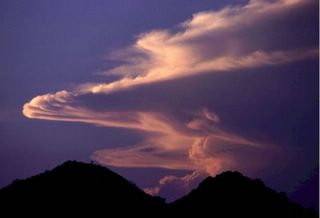** Weather Watch: Monsoon

Serious weather
Monsoon rains have come again to India, and they're dropping mind-boggling amounts of water on the land. On Tuesday, 37 inches (94 cm) of rain fell around Mumbai--a.k.a. Bombay. The city, a bustling financial hub packed with 17 million people, came to a halt as floodwaters flushed the streets. The city's chief meteorologist said, "Most places in India don't receive this kind of rainfall in a year. This is the highest ever recorded in India's history."
Of course, while monster monsoon rains don't always drop three feet of water in one day, India's monsoon does come every year. But don't think monsoons are all wet. Monsoons can bring drought as easily as floods.
What Are Monsoons?
Say "monsoon," and most people think "rain." But monsoons aren't rainstorms. They're wind systems that reverse direction when the seasons change, bringing dry weather as well as wet. In fact, the word monsoon comes from the Arabic mausim ("season"), which ancient Arab mariners used to refer to seasonal shifts in sea breezes.
Many countries have monsoonal climates, with strong seasonal winds, wet summers, and dry winters. Even the southwestern United States has a small-scale monsoon. But the Asiatic monsoon that washes over the Indian subcontinent every year is the mother of them all.
Like a Day at the Beach
If you've been to the beach on a hot day and hung around past sunset, you've likely experienced a mini-monsoon effect. During the day, the air over the beach heats up quickly, while the air over the water stays cooler (because water absorbs and retains more solar radiation than land). As the hot air over the land rises, cooler air from over the water rushes in to take its place, and you get a refreshing sea breeze.
After the sun sets, the air over the land cools off more quickly than the air over the water (again, because the water has absorbed more heat from the sun and can hold it longer). As the air over the water gets warmer than the air over the land, the breeze shifts. Now the warmer ocean air rises, while the cooler land air heads out to sea.
Getting Hotter, Getting Wetter
The same thing happens in and around the Indian subcontinent every year, but on a much larger scale. As March gives way to April and May, temperatures in India rise. By late spring, it's sweltering, with highs regularly above 100 degrees Fahrenheit (38 degrees Celsius).
But the mercury rises much more quickly above the land than it does above the Indian Ocean. Soon the cooler air moves inland, blowing in across the ocean and picking up moisture that falls to earth in torrential monsoon rains. Every year, those rains wreak havoc on the Indian subcontinent, even as they provide the water it needs to survive.
Cooling Down, Drying Off
Monsoon systems bring dry weather as surely as wet. In India, as summer gives way to autumn, temperatures fall, and they fall more quickly over the land than they do over the water. By October, India's winds generally blow out to sea, and they stay that way throughout winter and early spring.
When land winds prevail, India generally stays dry. Nothing wrong with dry weather, of course, as long as the wet season has been wet enough. When it hasn't, India's people face another of nature's killers: drought.
~ Steve Sampson



0 Comments:
Post a Comment
<< Home